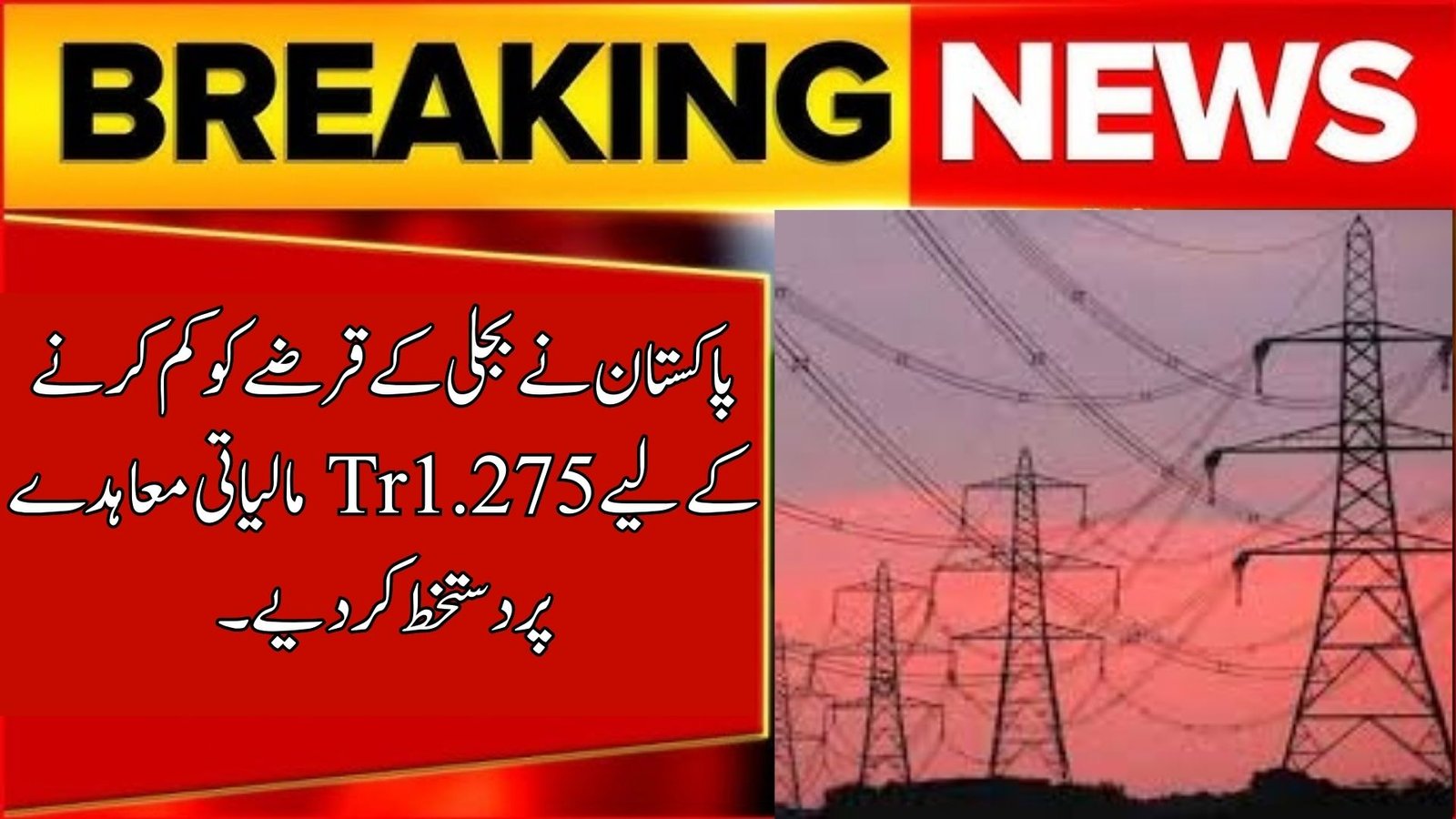Pakistan Signs Rs1.275 Tr Financing Deal to Ease Power Debt
Today, Pakistan’s government is finalizing a landmark financing agreement of Rs1.275 trillion with a consortium of 18 commercial banks. The purpose is to reduce the mounting circular debt in the power sector, shifting the repayment burden to electricity consumers via a surcharge, rather than increasing the burden on the national exchequer.
Quick Information Table For Pakistan Signs Rs1.275 Tr Financing Deal to Ease Power Debt
| Field | Details |
|---|---|
| Deal Name / Purpose | Rs1.275 trillion financing to ease power sector debt |
| Signing Date | September 24, 2025 |
| Repayment Duration | 6 years (24 quarterly installments) |
| Interest / Rate Terms | Concessional: KIBOR minus 0.90 basis points (effective 10.50–11.5%) |
| Amount to Retire Legacy Debt | Rs683 billion for PHL + Rs592 billion for IPPs |
| Recovery Method | Surcharge of Rs3.23 per unit on electricity bills, collected at source |
| Application / Mode | Legal & financial agreement; no “application” for public |
Context & Significance
What Is Circular Debt?
Circular debt refers to the chain of unpaid dues in Pakistan’s power sector — when power producers are not fully paid by DISCOs (distribution companies), and those in turn owe money to fuel suppliers or other entities, creating a cascading debt structure.
Why This Deal Is Important
- The IMF program demands reforms in the energy sector and fiscal stability.
- Clearing legacy debts helps improve liquidity in the power sector.
- The government claims this move will not add further burden to the state budget (exchequer).
- It is seen as a key step to stabilise the power sector and restore confidence in financial markets.
Prime Minister Shehbaz Sharif, currently in New York for the UN General Assembly, will join the signing virtually.
Structure & Components of the Agreement
Fresh Loans & Refinancing
- Of the total Pakistan Signs Rs1.275 Tr Financing Deal to Ease Power Debt, Rs617 billion will be provided as fresh loans by the banks at concessional rate (KIBOR minus 0.90).
- These loans will be repaid in 24 equal quarterly instalments over 6 years.
- The effective interest rate is expected to range between 10.50% and 11.5%.
Allocation of Funds
- Rs683 billion: to clear liabilities of Power Holding Company (PHL).
- Rs592 billion: to settle arrears for Independent Power Producers (IPPs).
Thus, the deal is designed to resolve two major categories of legacy debt in the sector.
Recovery via Surcharge (Debt Service Surcharge)
- A surcharge of Rs3.23 per unit is already in effect in electricity bills; this will be used to recover the new debt.
- The surcharge is collected at source, i.e. when consumers pay their electricity bills, the surcharge component is automatically deducted.
- The surcharge generates about Rs323 billion annually, which will be redirected to repay the banks.
- Whereas previously the surcharge had a 10% cap, that ceiling is now lifted to meet IMF benchmarks.
- Authorities emphasize that there’s no immediate plan to increase this Rs3.23 rate further.
No Sovereign Guarantee, Risk Sharing
Unlike earlier debt packages, this agreement is not backed by a sovereign guarantee (i.e., the government is not promising to pay if the sector fails). Instead, it is extended directly to CPPA-G, leveraging the power sector’s receivables.
This represents a shift in risk sharing, putting more responsibility on the sector itself rather than on state coffers.
Approval & Legal Steps
- Federal Cabinet Approval
In mid-June 2025, the cabinet approved the debt-restructuring plan. - Signing & Disclosure
The official signing is taking place today, with disclosure to the Pakistan Stock Exchange (PSX) and relevant stakeholders. - Board & CPPA-G Approval
CPPA-G’s board has already agreed to the revised terms in cooperation with participating banks. - Disbursement & Debt Clearance
Once funds are released, debts of PHL and IPPs will be cleared per the allocation. - Repayment Monitoring
Over six years, the surcharge will fund the instalments; progress will be monitored to ensure compliance and avoid accumulation of new circular debt.
Impact & Challenges for Pakistan Signs Rs1.275 Tr Financing Deal to Ease Power Debt
Positive Impacts
- Liquidity Relief: Clears long-standing dues of power producers and the holding company.
- Sector Stability: Reduces reliance on emergency governmental bailouts.
- Investor Confidence: Helps assure banks and investors that the power sector is undergoing reforms.
- Fiscal Discipline: Meets one of the IMF structural reforms required under the program.
Risks & Challenges
- The existing circular debt is still large: ~Rs1.66 trillion as of July 2025.
- Future buildup of debt must be prevented — unless systemic issues (line losses, inefficiency, non-payment) are fixed.
- If electricity consumers fail to pay, surcharge recoveries may lag.
- The removal of the surcharge cap may face public backlash if perceived as unfair.
- Ensuring that the sector continues with reforms — privatization of DISCOs, reducing losses — is essential to prevent relapse.
Updated Figures
- According to newer reports, the final signed deal might be Pakistan Signs Rs1.275 Tr Financing Deal to Ease Power Debt (slightly reduced) due to partial settlement by PHL before disbursement.
- The circular debt stock peaked earlier this year at Rs2.381 trillion but had already declined before this deal.
- Market response was strong: the Pakistan Stock Exchange (PSX) soared to new highs, partly driven by expectation of stability from this agreement.
So while the headline was Rs1.275 trillion, the ultimately executed figure is reported in some sources as Rs1.225 trillion.
What to Watch Going Forward
- Strict enforcement that surcharge collections go fully to repayment.
- No new accumulation of circular debt over the coming years.
- Reforms in power distribution companies (DISCOs) to reduce line losses and theft.
- Privatisation or restructuring of inefficient sectors in the power sector.
- Public monitoring and transparency in reporting how funds are used and debts are retired.
Conclusion
The signing of the Pakistan Signs Rs1.275 Tr Financing Deal to Ease Power Debt
marks a bold move by the Pakistani government to tackle its power sector’s persistent circular debt problem. By channeling repayment through a surcharge on consumers, foregoing a sovereign guarantee, and distributing funds to retire legacy obligations of PHL and IPPs, the deal aims to relieve immediate financial strain without pushing more burden on the national budget.
However, real success hinges on continued reforms — improving efficiency, reducing losses, and ensuring that the surcharge mechanism functions smoothly over the next six years. If the plan holds, this could become a turning point in stabilizing Pakistan’s power sector and restoring investor trust.
Related Posts









